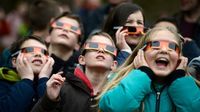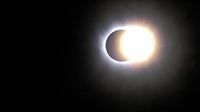Germany is gearing up for a partial solar eclipse that will unfold on March 29, 2025, with a remarkable 22 percent darkening of the sun visible across various regions of the country. Should the weather cooperate, skies will become a canvas for celestial drama as the moon passes between the Earth and the sun, creating this awe-inspiring phenomenon.
This astronomical event comes on the heels of a disappointing lunar eclipse that took place on March 14, 2025. The upcoming solar eclipse is anticipated to be a more engaging spectacle, lasting approximately 90 minutes. The peak of the eclipse will occur at different times, with the maximum darkening noted to reach its zenith in Erfurt at 12:15 PM, in Magdeburg at 12:17 PM, and in Görlitz at 12:19 PM.
Carolin Liefke from the Haus der Astronomie in Heidelberg emphasized, “Um die Finsternis zu sehen, müssen Sie im Schatten des Mondes sein.” (To see the eclipse, you must be in the shadow of the moon.) This statement underscores the localized nature of the eclipse, with Germany positioned at a distance from the optimal viewing path where the sun will be more dramatically obscured. Indeed, the highest levels of darkening will be observed not in Germany but rather over Greenland.
The eclipse’s shadow will trail across the globe, starting in the Atlantic Ocean and moving over Greenland, ultimately reaching the Arctic before it disappears after 1:00 PM German time. Certainly, the geographical position of viewers will affect the extent of coverage. For instance, Freiburg will experience peak obscuration around 12:08 PM, whereas Rostock and Stralsund will see peak moments at approximately 12:21 PM, with the event commencing 45 minutes before max coverage.
The safety of observers is paramount during eclipse viewings; using improper methods could lead to eye damage. Astronomers recommend utilizing eclipse glasses designed for such observations, along with specialized filters for telescopes. Additionally, various observatories and astronomy clubs across Germany are hosting events to provide safe and guided viewing opportunities.
Many enthusiasts are also encouraged to engage in optical experiments during the eclipse. For example, you can use a simple pair of binoculars to project the sun’s image onto a sheet of paper, provided one lens is covered to create a focused image. Alternatively, a pinhole camera can be crafted using a cardboard tube—only a small hole is needed to make this method effective. As the saying goes, creativity shines when it comes to observing the wonders of the universe!
The joint celebration of this celestial event, dubbed Germany-wide Astronomy Day, is set to take place on March 29, aligning with the eclipse. Various astronomical institutions, including the Friedrich-Schiller-Gymnasium Weimar and the Sternwarte Hartha, encourage individuals—both amateur and seasoned astronomers—to partake in community viewing sessions. Even after the solar spectacle, the evening offers additional sights, with planets like Mars and Jupiter prominently positioned for observation.
Looking ahead, astronomers also note the significance of future solar eclipses, with another partial solar eclipse expected in August 2026 that promises to offer a greater level of obscuration than the upcoming event. Liefke commented, “Sie wird eine deutlich größere Verfinsterung haben als die bevorstehende.” (It will have a significantly greater obscuration than the upcoming one.) The next total eclipse visible in Germany isn’t predicted until September 3, 2081, marking a long wait for aficionados of this cosmic event.
While eager spectators prepare for the upcoming eclipse, it invigorates discussions around astronomy and the various ways celestial bodies can be observed safely. The event serves not only as a natural phenomenon but also as a communal experience, reminding everyone of the wonders held beyond our earthly frame.
As the date approaches, the anticipation builds. Whether through telescopes or simple gadgets at home, the partial solar eclipse on March 29 is sure to provide a dazzling experience for observers across Germany.





